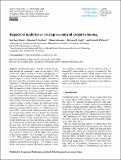| dc.contributor.author | Sanz-Morère, Inés | |
| dc.contributor.author | Eastham, Sebastian David | |
| dc.contributor.author | Allroggen, Florian | |
| dc.contributor.author | Speth, Raymond L | |
| dc.contributor.author | Barrett, Steven R. H. | |
| dc.date.accessioned | 2021-04-08T12:30:47Z | |
| dc.date.available | 2021-04-08T12:30:47Z | |
| dc.date.issued | 2021-02 | |
| dc.identifier.issn | 1680-7316 | |
| dc.identifier.uri | https://hdl.handle.net/1721.1/130407 | |
| dc.description.abstract | Condensation trails ("contrails") which form behind aircraft are estimated to cause on the order of 50 % of the total climate forcing of aviation, matching the total impact of all accumulated aviation-attributable CO2. The climate impacts of these contrails are highly uncertain, in part due to the effect of overlap between contrails and other cloud layers. Although literature estimates suggest that overlap could change even the sign of contrail radiative forcing (RF), the impacts of cloud contrail overlaps are not well understood, and the effect of contrail contrail overlap has never been quantified. In this study we develop and apply a new model of contrail radiative forcing which explicitly accounts for overlap between cloud layers. Assuming maximum possible overlap to provide an upper bound on impacts, cloud contrail overlap is found to reduce the shortwave-cooling effect attributable to aviation by 66 % while reducing the longwave-warming effect by only 37 %. Therefore, on average in 2015, cloud contrail overlap increased the net radiative forcing from contrails. We also quantify the sensitivity of contrail radiative forcing to cloud cover with respect to geographic location. Clouds significantly increase warming at high latitudes and over sea, transforming cooling contrails into warming ones in the North Atlantic corridor. Based on the same data, our results indicate that disregarding overlap between a given pair of contrail layers can result in longwave and shortwave radiative forcing being overestimated by up to 16 % and 25 %, respectively, with the highest bias observed at high optical depths (> 0.4) and high solar zenith angles (> 75°). When applied to estimated global contrail coverage data for 2015, contrail contrail overlap reduces both the longwave and shortwave forcing by ∼ 2 % relative to calculations which ignore overlap. The effect is greater for longwave radiation, resulting in a 3 % net reduction in the estimated RF when overlap is correctly accounted for. This suggests that contrail contrail overlap radiative effects can likely be neglected in estimates of the current-day environmental impacts of aviation. However, the effect of contrail contrail overlap may increase in the future as the airline industry grows into new regions. | en_US |
| dc.description.sponsorship | NASA Glenn Research Center (Grant NNX14AT22A) | en_US |
| dc.language.iso | en | |
| dc.publisher | Copernicus GmbH | en_US |
| dc.relation.isversionof | 10.5194/acp-21-1649-2021 | en_US |
| dc.rights | Creative Commons Attribution 4.0 International license | en_US |
| dc.rights.uri | https://creativecommons.org/licenses/by/4.0/ | en_US |
| dc.source | Copernicus Publications | en_US |
| dc.title | Impacts of multi-layer overlap on contrail radiative forcing | en_US |
| dc.type | Article | en_US |
| dc.identifier.citation | Sanz-Morère, Inés et al. “Impacts of multi-layer overlap on contrail radiative forcing.” Atmospheric Chemistry and Physics, 21, 3 (February 2021): 1649–1681 © 2021 The Author(s) | en_US |
| dc.contributor.department | Massachusetts Institute of Technology. Laboratory for Aviation and the Environment | en_US |
| dc.contributor.department | Massachusetts Institute of Technology. Joint Program on the Science & Policy of Global Change | en_US |
| dc.contributor.department | Massachusetts Institute of Technology. Department of Aeronautics and Astronautics | en_US |
| dc.relation.journal | Atmospheric Chemistry and Physics | en_US |
| dc.eprint.version | Final published version | en_US |
| dc.type.uri | http://purl.org/eprint/type/JournalArticle | en_US |
| eprint.status | http://purl.org/eprint/status/PeerReviewed | en_US |
| dc.date.updated | 2021-04-07T18:46:49Z | |
| dspace.orderedauthors | Sanz-Morère, I; Eastham, SD; Allroggen, F; Speth, RL; Barrett, SRH | en_US |
| dspace.date.submission | 2021-04-07T18:46:51Z | |
| mit.journal.volume | 21 | en_US |
| mit.journal.issue | 3 | en_US |
| mit.license | PUBLISHER_CC | |
| mit.metadata.status | Complete | |
